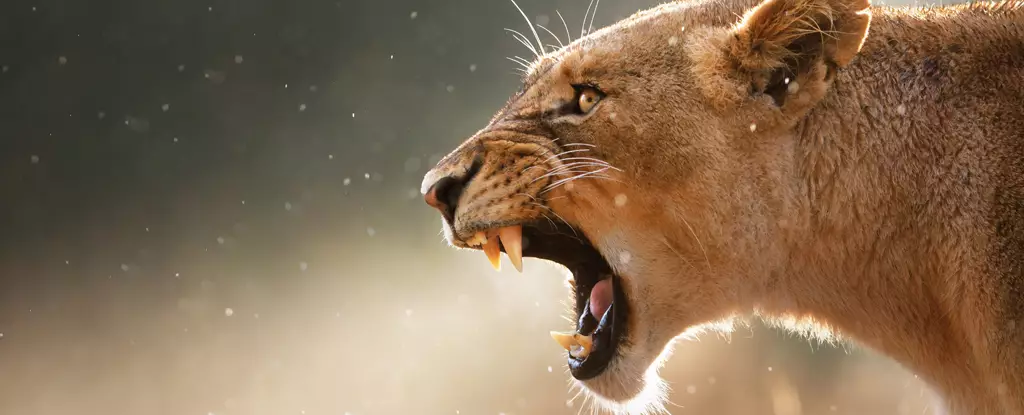When we think of apex predators in the animal kingdom, our minds are often drawn to the formidable lion, with its muscular build, sharp claws, and fearsome fangs. Dubbed the “king of the jungle,” lions exemplify strength and predatory prowess. However, recent research provides a startling revelation: while lions are indeed formidable, the sheer presence and sounds of humans evoke greater terror among wildlife than the roar of a lion. This paradigm shift challenges our understanding of who the true apex predator is and why the fear of humans has permeated the wild in a way that even the loudest growls cannot.
In a groundbreaking study published by a team from Western University, investigation into animal responses to various sounds in South Africa’s Greater Kruger National Park revealed an unsettling truth. The research involved over 10,000 recordings of diverse wildlife interactions and found that approximately 95% of observed species responded with more alarm to human vocalizations than to the menacing sounds of lions. For a conservation biologist like Michael Clinchy, this was not just a surprising twist but also a clear indicator that humans instill a deep-rooted fear in wildlife.
The researchers played sounds of human life, including conversations in various languages and hunting noises, contrasting them with lion vocalizations. Astonishingly, the results were conclusive. Animals like giraffes, elephants, leopards, and warthogs displayed a marked increase in anxiety when humans were the focus of the auditory stimuli, suggesting that their innate fear of humans far exceeds their instinctive caution around even the most powerful predators, such as lions.
The Behavioral Responses of African Mammals
The implications of these findings are profound. The study observed 19 different mammal species and concluded that the sound of human voices made them twice as likely to abandon waterholes compared to sounds from lions or hunting dogs. This response underlines how the animals perceive humans not as just another part of their ecosystem, but as a primary threat. Elephants, known for their intelligence and emotional depth, even reacted violently to lion sounds, illustrating a complex emotional landscape where vocalizations can provoke intense feelings and irrational behaviors.
Despite the similarities in danger posed by lions, the fear cultivated by human presence is unique. Clinchy’s commentary on this fear suggests an evolutionarily ingrained response—resulting in a learned wariness that shapes wildlife behavior. The revelation that humans are perceived as the ultimate danger fundamentally alters how we approach wildlife conservation and ecosystem management.
The Ramifications of Human Presence
The reality of human influence does not end with the immediate reaction of animals to our sounds. The fear induced by our presence has long-term ramifications for wildlife populations. Species that already face challenges like habitat loss and poaching are further threatened by the anxiety rooted in their experiences with humans. The research highlights that prolonged exposure to fear can lead to diminished populations over generations, posing a critical threat to biodiversity in the savannah.
Moreover, the impact of human-induced fear isn’t merely limited to direct interactions. The mere existence of humans evokes a survival instinct among wildlife, leading to altered foraging habits, mating behaviors, and social structures. For many of these species, adapting to evade human threats might come at the cost of their natural behaviors, leading to a decline in their overall health and resilience.
Yet, these findings may also present fresh avenues for wildlife conservation strategies. Understanding how fear works can be a vital tool in protecting vulnerable species. For example, utilizing human sounds in areas notorious for poaching could keep endangered animals such as the Southern white rhino from coming into harm’s way.
As conservationists explore these new methodologies, Liana Zanette’s assertion resonates: the fear embedded in the savannah ecosystem encapsulates the broader environmental impact of human activity. By acknowledging our role in fostering both awe and terror among wildlife, we can begin to bridge the divide between humans and nature, potentially shaping a future where coexistence is not rooted in fear, but rather in understanding and respect.
As the most dominant species on the planet, humans wield unprecedented influence over ecosystems and wildlife behavior. The revelation that our very presence generates a profound response among wildlife forces us to re-evaluate our interactions with nature. Understanding that we are perceived as instigators of fear—more so than well-known predators—challenges the narrative of humanity as simply a part of nature’s balance. It compels us to consider how we might act responsibly within our role in shaping the world around us, ensuring that we nurture rather than terrorize the stunning diversity of life that shares our planet.


Leave a Reply